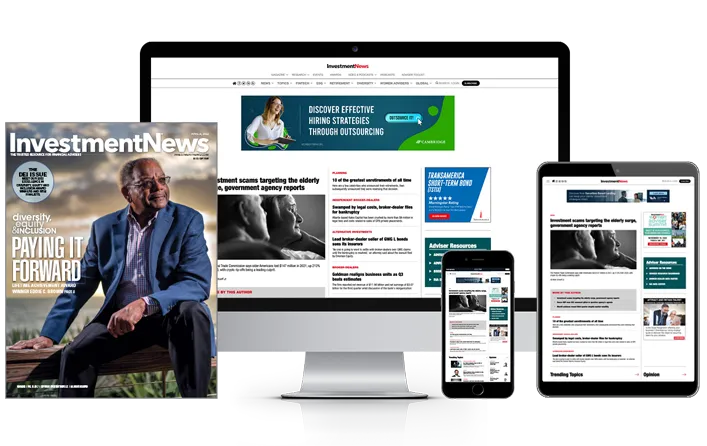

Most people are familiar with the leapfrog deployment of telecom technology in developing countries, when billions of people who never owned a phone skipped landlines and went straight to mobile. Today’s adviser industry can play leapfrog when it comes to risk management. Instead of engaging in a debate over which 30-year-old approach to risk management is better, advisers can jump to the best of current institutional risk management approaches, adapted to the unique challenges presented by working with individual investors.
The standard approach to risk management was developed in the early 1990s to help banks understand their trading risks. A decade later, it found application for the buy side -- the hedge funds and then asset management firms. I've applied these tools as a chief risk officer in both settings and have an intimate understanding of their limitations.
When I started my career in risk management nearly 30 years ago, we measured the risk of future loss by looking at historical returns, using metrics like Value at Risk (VaR). This came with a pronounced assumption: The future will look like the past. Perhaps that's helpful for the typical day-to-day, but risk systems don't earn their keep in the humdrum of uneventful days. When risk really matters, we have to move beyond this.
Another common tool in the standard risk arsenal was the stress test, a “what if” approach where we might ask, "What happens to my portfolio if stocks drop 25%?" Stress tests have their own limitations. First, they use canned stresses of everything under the sun, and I wouldn't be doing my job as a risk manager if I simply said, "Be careful, anything could happen." Second, as anyone who lived through the bursting of the internet bubble or the 2008 banking debacle knows, market crises don't happen all in one shot. Instead, they propagate and cascade as a dynamic, a story with twists and turns in the plot.
So as a start, let's not be outdated. We can't manage through the rearview mirror; we need to look at the current market conditions and market vulnerability. We can't approach a "what if" in a rote, mechanistic way; we need to construct scenarios thoughtfully and respect the process for how risk might unfold.
Whatever the shortcomings of the standard approach, there is a deeper issue we need to consider. The role of wealth managers and the problems faced by their clients are different -- and more complex -- than those of the banks and asset managers. Banks and asset managers are focused myopically on monthly – even daily – variability, whereas the risk for a client extends out for years. Moreover, banks and asset managers are focused squarely on returns, whereas the adviser faces the multidimensional objective of marrying portfolio performance with the client's long-term goals.
So unlike the asset manager, the adviser has risk coming from both the market and the client. Neither the client nor the client's portfolio is going to be the same in the future as they are now. Risk appetite is dynamic, changing with market and life experiences; risk capacity likewise is dynamic, changing with the market and the client’s wherewithal to meet goals.
So advisers have two tasks. The first and most obvious is getting the market risk right. And we cannot get an adequate view of market risk if we only use history, or if we impose static, uninspired stress cases to project the future. The second task is to integrate any assessment of market risk with the risk coming from the client, a risk that in part dynamically feeds through from the market, and in part occurs simply by living. Here we cannot have an adequate view if we don’t actively look to imagine — and continually reimagine — all of the possible future worlds that our client might encounter.
The client will be more secure when the adviser takes this complete and up-to-date approach to risk. And clients intuitively understand this. They know that the span of uncertainty extends beyond the markets as they look forward to their life's adventure. They recognize from their own market experiences that as the world and the markets evolve, they will not be a repeat of the past. So not only will the client be more secure, but the adviser will better hold the client’s trust.
Rick Bookstaber is founder and head of risk at Fabric RQ. He has held chief risk officer roles at Morgan Stanley, Salomon, Bridgewater and the University of California Regents Pension Fund and served at the Treasury in the aftermath of the 2008 financial crisis. He is the author of The End of Theory (Princeton University Press, 2017) and A Demon of Our Own Design.

Relationships are key to our business but advisors are often slow to engage in specific activities designed to foster them.

Whichever path you go down, act now while you're still in control.

Pro-bitcoin professionals, however, say the cryptocurrency has ushered in change.

“LPL has evolved significantly over the last decade and still wants to scale up,” says one industry executive.

Survey findings from the Nationwide Retirement Institute offers pearls of planning wisdom from 60- to 65-year-olds, as well as insights into concerns.
Streamline your outreach with Aidentified's AI-driven solutions
This season’s market volatility: Positioning for rate relief, income growth and the AI rebound
